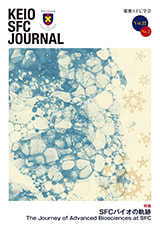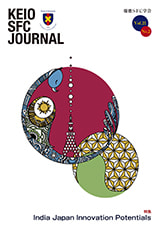- HOME
- KEIO SFC JOURNAL
- Vol.22 No.1

Toshihiro Nakayama and the SFC
| Ken Jimbo (Professor, Faculty of Policy Management, Keio University) |
-
[Research articles]
Diversity Inclusion and Societal Imperatives in the U.S. Military ―Minorities in West Point
Daisuke Hoshino (Doctral Program, Graduate School of Media and Governance, Keio University) This article explores the struggle and balance between America’s societal imperative to integrate minorities into the military and the functional imperative by the military’s culture through the minority inclusion at the United States Military Academy, West Point, since the 1970s. As a symbolic Army institution, West Point has been integrated racial and gender minorities in response to social change and civilian oversight. West Point minority graduates have met the functional imperatives by fighting America’s war and breaking through the glass ceiling to redefine the masculine military identity.
Download this article (PDF): SFCJ22-1-01.pdf
-
[Research articles]
An Evaluation of Optimal Space of a 3D-Printed Scaffold for a Cricket-Breeding Module
Takuya Onishi (Doctoral Program, Graduate School of Media and Governance, Keio University) Giovanni Innella (Assistant Professor, Department of Master of Fine Arts in Design Studies, VCUarts Qatar, Doha, Qatar) Hiroto Kobayashi (Professor, Graduate School of Media and Governance, Keio University) Fumitoshi Kato (Professor, Department of Environment and Information Studies, Keio University) Crickets will gain importance as a future animal protein source. Optimizing the design of their living space is vital to further their mass production. To obtain data that can be used as a reference for realizing it, four types of truncated octahedron frame shelters (scaffold modules) with sides measuring 9, 11, 13, and 15 mm were created with a 3D printer. Shelters occupied most of the crickets’ living space, and their preference for these frames was examined. Results found crickets tend to prefer the 9 mm scaffold module. Considering the industrial benefits of low weight, the lighter 11 mm scaffold module, with the second-highest cricket preference, is optimal for large-scale cricket farming.
Download this article (PDF): SFCJ22-1-02.pdf
-
[Research articles]
Chisaki Asano (Doctoral Student, Department of Language and Information Sciences, Graduate School of Arts and Sciences, The University of Tokyo) As a leading figure of the Haitian Spiralism, a literary movement commenced in the early 1970s, Frankétienne conserves its aesthetic philosophy at the heart of his writing to this day. Due to the absence of a canonical theory officially declared by the founders, the Spiralism manifests with its intension and configurative strategies being opaque. Convinced of Frankétienne as being a cornerstone of the contemporain Haitian literature, this paper tries to seize the contour and motive force of his Spiralism, observed in his literatures and comments in interviews.
Download this article (PDF): SFCJ22-1-03.pdf
-
[Research articles]
Inhabiting the Exhibition Site Through Dōjinshi ―The Role of Fan Works in Place-Making /h2>
Estelle Rust (Doctoral Program, Graduate School of Media and Governance, Keio University) The changing and malleable exhibition space is one regularly considered from the perspective of curator and audience. This paper brings forward an alternate one: that of the object. Such a perspective is revealed in analysis of exhibition dōjinshi (fan works) inspired by Japanese popular culture: in particular, those written by the female fanbase of the franchise ‘Touken Ranbu’. Their works imagine Japanese swords as social inhabitants, and bring a new perspective to the discussion of exhibition spatiality and purpose of display, centring the object and rendering the exhibition a communicative space between humans and non-humans.
Download this article (PDF): SFCJ22-1-04.pdf
-
[Review articles]
A Literature Review on Reflection for New Graduated Nurses Education
Yuri Dohi (Master’s Program, Department of Psychiatric Nursing, Graduate School of Medicine, The University of Tokyo) Kiyoka Nozue (Professor, Faculty of Nursing and Medical care, Keio University) A literature review was conducted to clarify the content and effects of education for new graduated nurses using reflection. From 51 references extracted through a database search using Ichushi-Web, seven references that met the research objectives were selected for review. By using a variety of tools for reflection, such as journals, notebooks, and videos, senior nurses’ giving emotion-focused and open questions, new graduated nurses are encouraged to think what their feeling and attitude in the situation was. Through thinking, new graduated nurses became aware of their limitations and strengths, negative emotions were reduced, and their motivation for growth increased, while senior nurses gained a deeper understanding of the new graduated nurses and self-understanding and gained confidence in their guidance.
Download this article (PDF): SFCJ22-1-05.pdf
-
[Practical reports]
A Study on the Involvement of Learning Supporters to Influencing Students’ Growth in Clinical Practicum
Chihiro Kaminoyama (Nurse, The University of Tokyo Hospital) Chika Yoshigi (Nurse, Toranomon Hospital) Mihoko Miyawaki (Professor Emeritus, Keio University) The aim of this study was to investigate the personal growth of nursing students in clinical practicum through their relationships with learning supporters. For this purpose, this study investigated to six fourth-year undergraduates who experienced the practicum, and conducted semi-structured interviews. The results showed that the participants perceived their interactions with the learning supporters as “those that led to growth” and “those that did not lead to growth”. It was suggested that the interested involvement of the learning supporters had a strong influence on the growth of the students in the practicum.
Download this article (PDF): SFCJ22-1-06.pdf

